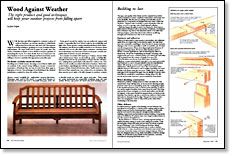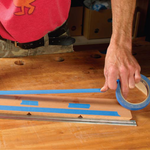Wood Against Weather
The right product and good techniques will keep your outdoor projects from falling apart
Synopsis: When it comes to outdoor furniture, you have to decide how you want it to look over its lifespan and how much time you’re willing to invest to maintain that appearance year after year. You can leave the wood without a finish or you can choose a glossy topcoat. In this article, Jim Tolpin discusses resistance to rot, long-lasting protection, and gloss retention. Side information covers adhesives, fasteners, water-shedding construction, and other defenses that will make your outdoor furniture last. There’s also a detailed discussion of how to prepare the wood surface and how to apply exterior varnish and paint.
With the time and effort required to construct a piece of outdoor furniture, an obvious question is what finish will protect it from the sun, rain and cold. The answers range from doing nothing to spraying on a coat of catalyzed linear polyurethane, the same stuff used to paint 747 jumbo jets. The choice of whether to finish or not to finish is not just a question of protecting the wood. You must decide how you want your outdoor furniture to look over its lifespan and how much time you’re willing to invest to maintain this appearance year after year.
No finish: carefully choose the wood
Deciding not to finish means choosing a wood that is stable and rot resistant. It also means being willing to accept a coarse-textured piece of furniture that can vary in color from silver gray to dark gray or brown. The advantage of not finishing is the minimal maintenance required to keep the surface clean.
Some good woods for outdoor use are redwood, cypress and cedars. I especially like Port Orford cedar for its workability and light color. These species contain natural pesticides in their chemical makeup, and all are incredibly resistant to rot. However, these relatively soft woods offer little impact resistance, and they have been extensively over-harvested. But in recent years, several companies have formed to recycle old timbers.
For a harder wood that will stand up to bumps, choose white oak or black locust. These woods build up tyloses, a bubble-like formation that blocks the penetration of water into the cell structure, making them particularly well-suited for outdoor use. Two other woods usually associated with indoor furniture, black cherry and walnut, surprisingly rate with the cedars in decay resistance because of their closed-cell structure. Also, Pacific yew is a beautiful wood that outperforms even redwood in rot resistance.
From Fine Woodworking #100
For the full article, download the PDF below:
Fine Woodworking Recommended Products

3M Blue Tape

Veritas Wheel Marking Gauge

Odie's Oil





















Log in or create an account to post a comment.
Sign up Log in